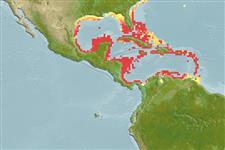Teleostei (teleosts) >
Clupeiformes (Herrings) >
Spratelloididae (Small round herrings)
Eponymy: Dr Oliver Peebles Jenkins (1850–1935) was a physiologist and ichthyologist. [...] (Ref. 128868), visit book page.
Issue
The species in the genera Spratelloides Bleeker, 1851 and Jenkinsia Jordan & Evermann, 1896 should most probably be assigned to a separated family from Clupeidae and Dussumieriidae (Lavoué, pers. comm., July 2013). See a preliminary analysis in Lavoué et al. (2013: Ref. 93878).
Environment: milieu / climate zone / depth range / distribution range
Ecology
Marine; reef-associated; depth range 0 - 50 m. Subtropical; 34°N - 8°N, 100°W - 60°W (Ref. 188)
Western Central Atlantic: Bermuda, Florida (USA), Gulf of Mexico and Caribbean south to Tobago. Antilles (Ref. 26938).
Length at first maturity / Size / Weight / Age
Maturity: Lm 2.8, range 2 - ? cm
Max length : 7.5 cm TL male/unsexed; (Ref. 9710)
Dorsal spines (total): 0; Anal spines: 0; Vertebrae: 40 - 43. Lower gill raker counts, show some correlation with geographical area, suggesting that the species may comprise three races or subspecies. W-shaped pelvic scute; pre-maxillae toothed, 1 supra-maxilla; isthmus slender, but with slight 'shoulders' anteriorly; vertebrae 40 to 43 (usually 42 - Venezuela); silver lateral band not becoming narrower or fading near gill opening (Ref. 188). Chest is slightly keeled. Small anal fin. Faintly greenish above (Ref. 37032).
A schooling species usually occurring inshore. Feeds on zooplankton. Preyed upon by many larger fishes and squids (Ref. 5521). Important as live bait for scombrids (Ref. 26340). In 1937, at Kingston, Jamaica it spawns during the winter months. Travels long distance (Ref. 37032).
Life cycle and mating behavior
Maturity | Reproduction | Spawning | Eggs | Fecundity | Larvae
Whitehead, P.J.P., 1985. FAO Species Catalogue. Vol. 7. Clupeoid fishes of the world (suborder Clupeoidei). An annotated and illustrated catalogue of the herrings, sardines, pilchards, sprats, shads, anchovies and wolf-herrings. FAO Fish. Synop. 125(7/1):1-303. Rome: FAO. (Ref. 188)
IUCN Red List Status (Ref. 130435: Version 2024-2)
Threat to humans
Harmless
Human uses
Fisheries: minor commercial; bait: usually
Tools
Special reports
Download XML
Internet sources
Estimates based on models
Preferred temperature (Ref.
123201): 24.4 - 28, mean 26.8 °C (based on 200 cells).
Phylogenetic diversity index (Ref.
82804): PD
50 = 0.5625 [Uniqueness, from 0.5 = low to 2.0 = high].
Bayesian length-weight: a=0.00692 (0.00360 - 0.01331), b=3.26 (3.09 - 3.43), in cm total length, based on LWR estimates for this species & (Sub)family-body (Ref.
93245).
Trophic level (Ref.
69278): 3.3 ±0.3 se; based on diet studies.
Generation time: 0.3 ( na - na) years. Estimated as median ln(3)/K based on 1
growth studies.
Resilience (Ref.
120179): High, minimum population doubling time less than 15 months (tm<1; K>0.3).
Fishing Vulnerability (Ref.
59153): Low vulnerability (10 of 100).
Nutrients (Ref.
124155): Calcium = 177 [73, 638] mg/100g; Iron = 2.61 [0.98, 5.72] mg/100g; Protein = 19.7 [17.9, 21.3] %; Omega3 = 0.356 [0.102, 1.308] g/100g; Selenium = 34 [9, 124] μg/100g; VitaminA = 26.6 [4.9, 168.4] μg/100g; Zinc = 2.25 [1.12, 4.22] mg/100g (wet weight);
